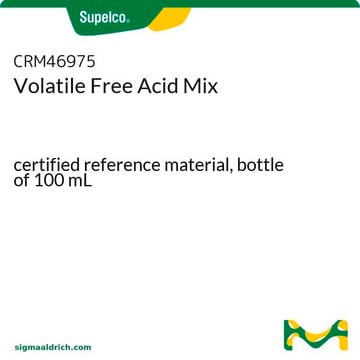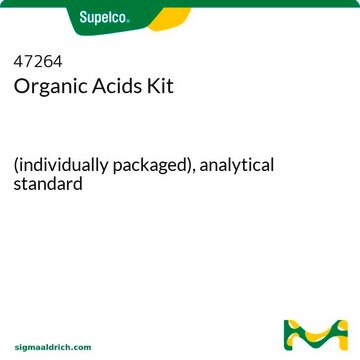SBR00035
13C-Short Chain Fatty Acids Stool Mixture
Suitable for mass spectrometry
Sinonimo/i:
SCFA, Sodium acetate-13C2, Sodium butyrate-13C4, Sodium propionate-13C3, Stool
Autenticatiper visualizzare i prezzi riservati alla tua organizzazione & contrattuali
About This Item
Codice UNSPSC:
12352211
NACRES:
NA.25
Prodotti consigliati
Descrizione generale
Short chain fatty acids (SCFAs) are saturated fatty acids with less than 6 carbons. SCFAs are produced in the gut by microbial fermentation of dietary fibers. The most important and researched SCFAs are Acetate (Ac), propionate (Pr) and butyrate (Bu). SCFAs are predominantly found in the colon and cross the intestinal epithelium to the blood stream. SCFAs were found to be beneficial and effective in prevention of obesity, Non-alcoholic fatty liver disease and insulin resistance.
The concentration of SCFAs in Stool is varied from subject to subject in dependence to the experiment parameters. The Average concentration for Acetate, Propionate and Butyrate 30, 10, 10 μM respectively.
13C-SCFAs can serve in various applications:
The concentration of SCFAs in Stool is varied from subject to subject in dependence to the experiment parameters. The Average concentration for Acetate, Propionate and Butyrate 30, 10, 10 μM respectively.
13C-SCFAs can serve in various applications:
- spiking the mixture to track sample preparation errors.
- QC sample, to exclude run to run variations and to normalize the runs.
- Calibration curve to quantify SCFAs in Stool samples.
Codice della classe di stoccaggio
12 - Non Combustible Liquids
Classe di pericolosità dell'acqua (WGK)
nwg
Punto d’infiammabilità (°F)
Not applicable
Punto d’infiammabilità (°C)
Not applicable
Certificati d'analisi (COA)
Cerca il Certificati d'analisi (COA) digitando il numero di lotto/batch corrispondente. I numeri di lotto o di batch sono stampati sull'etichetta dei prodotti dopo la parola ‘Lotto’ o ‘Batch’.
Possiedi già questo prodotto?
I documenti relativi ai prodotti acquistati recentemente sono disponibili nell’Archivio dei documenti.
Ara Koh et al.
Cell, 165(6), 1332-1345 (2016-06-04)
A compelling set of links between the composition of the gut microbiota, the host diet, and host physiology has emerged. Do these links reflect cause-and-effect relationships, and what might be their mechanistic basis? A growing body of work implicates microbially
Emanuel E Canfora et al.
Nature reviews. Endocrinology, 15(5), 261-273 (2019-01-24)
Evidence is accumulating that the gut microbiome is involved in the aetiology of obesity and obesity-related complications such as nonalcoholic fatty liver disease (NAFLD), insulin resistance and type 2 diabetes mellitus (T2DM). The gut microbiota is able to ferment indigestible
J H Cummings et al.
Gut, 28(10), 1221-1227 (1987-10-01)
Evidence for the occurrence of microbial breakdown of carbohydrate in the human colon has been sought by measuring short chain fatty acid (SCFA) concentrations in the contents of all regions of the large intestine and in portal, hepatic and peripheral
Tara M Henagan et al.
British journal of pharmacology, 172(11), 2782-2798 (2015-01-07)
Sodium butyrate (NaB), an epigenetic modifier, is effective in promoting insulin sensitivity. The specific genomic loci and mechanisms underlying epigenetically induced obesity and insulin resistance and the targets of NaB are not fully understood. The anti-diabetic and anti-obesity effects of
Il team dei nostri ricercatori vanta grande esperienza in tutte le aree della ricerca quali Life Science, scienza dei materiali, sintesi chimica, cromatografia, discipline analitiche, ecc..
Contatta l'Assistenza Tecnica.








